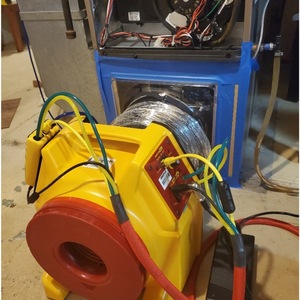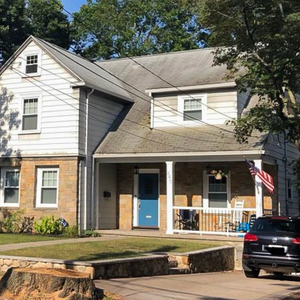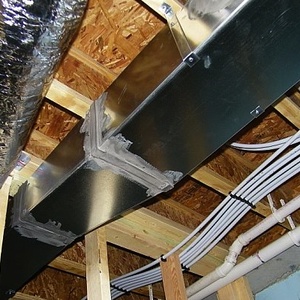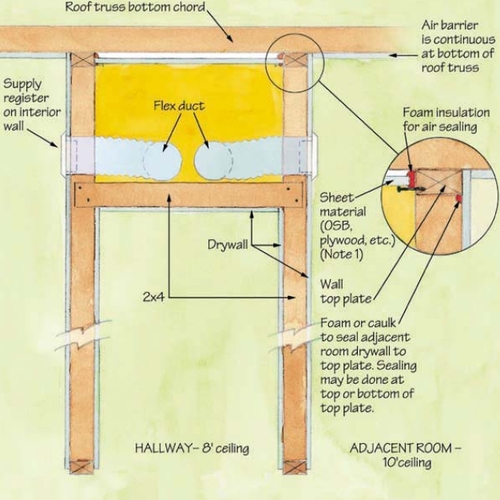
Ducts running through unconditioned attics or crawlspaces can create problems in all climates. Undesirable positive or negative pressurization, moisture and mold issues, and increased energy costs are often the result. In my work as an energy auditor, I’ve conducted blower door tests on many new homes that have duct work located outside the building envelope, many with poor test results.
As a matter of fact, of all the new homes I have tested that have failed code-required blower door tests, all had ducts in unconditioned attics or crawl spaces. With so many new slab-on-grade homes being built today, lots of designers and builders are trying to figure out: where is the best place to put the duct work? Before we get to that question, let’s look at some of what the 2018 International Residential Code (IRC) says about ducts outside of the building envelope.
What the IRC has to say about ducts
N1103.3 Ducts. Ducts and air handlers shall be in accordance with Sections N1103.3.1 through N1103.3.8.
N1103.3.1 Insulation (Prescriptive). Supply and return ducts in attics shall be insulated to an R-value of not less than R-8 for ducts 3 in. in diameter and larger and not less than R-6 for ducts smaller than 3 in. in diameter. Supply and return ducts in other portions of the building shall be insulated to not less than R-6 for ducts 3 inches in diameter and to not less than R4.2 for ducts smaller than 3 inches in diameter.
Exception: Ducts or portions thereof located completely inside the building thermal envelope.
N1103.2.2 Sealing (Mandatory). Ducts, air handlers, and filter boxes shall be sealed. Joints and seams shall comply with section M1601.4.1 of this code.
N1103.3.2.1 Sealed air handler. Air handlers shall have a manufacturer’s designation for an air leakage of not greater than 2% of the…
Weekly Newsletter
Get building science and energy efficiency advice, plus special offers, in your inbox.

This article is only available to GBA Prime Members
Sign up for a free trial and get instant access to this article as well as GBA’s complete library of premium articles and construction details.
Start Free TrialAlready a member? Log in















11 Comments
Slab-on-grade w/ducts in a vented attic has been the standard in the SE US for decades. Especially with production builders.
Of course this is done for cost reasons because:.
- HVAC within the building envelope takes up interior space and there's the noise issue. For example imagine trying to design a system for a 2-3 story townhome with an open floor plan.
- Production builders like to offer options with regards to room configurations. HVAC inside the envelope adds additional complexity and that means higher costs.
-Expensive solution: Spray foam. I believe there is one production builder who figured out a cost effective way to use ocSPF underneath the roof deck. This allows them to retain the flexibility with regards to differing floor-plans and standardizes the install for the HVAC contractor.
Now if we could only get them to stop using ductboard. ;)
Meritage Homes in CA and AZ is doing ocSPF under roof decks and walls, they also blower door test every home they build. They also installed a nice duct system in all the houses in my subdivision, no ductboard! BUT... they installed 3.5 ton A/C and 88kbtu furnace on my house while I modeled it at only 17,600 btu heat load, 15,400 btu cooling load.
I walked through a new construction home (rebuilt on existing foundation) outside of Boston, and the air handler/furnace/water heater was in the garage. This mind you was a $1.6m home, with a single 100% below grade garage door with finished basement. I'm sure the walls are all insulated minus a leaky garage door, but having your HVAC for your home shared with your car exhaust seems insane to me.
One of the new homes I tested that failed the code compliant blower door test failed for that reason. Ductwork was in the attic, I believe air sealed and insulated with closed cell spray foam but the door to the room where the HVAC equipment was installed, inside the garage, was a standard interior door. I was pulling air from the garage, through the forced air furnace and into the home.
I found a pic on the listing. Lots of air to pull through those doors.
Low delta P heat pump air handler, well sealed, in garage seems OK, as long as all penetrations are well sealed. The negative pressure is quite low (and if w/short run) and supply is positive pressure, so seems like, while not optimal, can be doable. Most modern cars, or how about electric cars, reduce or eliminate many risks. Blower door is not representative of any normal operating condition. Just wanted to edit to say, great article and thanks for posting.
I’m guessing this was a traditional air handler and not heat pump system.
Mitsubishi SEZ, horizontal ducted air handler (0.2 in W.G.) connected to air-to-air heat pump (outside), with about 2' long duct to intake, which I assume is where the risk of entraining garage space air would be - supply side leakage, if any, would likely leak from air handler/supply duct to garage space. Garage is sprayfoamed (walls/ceiling w/living space above) and has an insulated panel garage door with minimal leakage at edges (nothing more than about 1/4 inch near bottom corners). All ducts insulated and SEZ insulated to some extent too. House is well below 3 ACH50.
I have blower door tested several homes with utility closets in attached, heated garages. Most have exterior doors leading from the garage into the utility space. All but a couple use gas boilers for in-floor hot water heating systems. They also contain an HRV. The ducts for the HRV end up in the vented attic. I'm sure there is some leakage around the penetrations through the air barrier and maybe a little in the duct connections, but I have not had a home with this configuration fail a blower door test. The home in comment #3 had a forced air system in a utility closet located in the garage with poorly sealing interior doors. If my memory is correct, this slab on grade home tested at over 4 ACH50. I agree, utility closets in garages that are well air sealed can work. That being said, any home that I have design input will have the HVAC systems inside the home.
Plenum trusses are a great solution. Another good one is hydronic with cooling through the use of mini-slim fan-coil units like those available from Chiltrix. They are smaller and slimmer than minisplit heads and thus avoid the aesthetic objection, and in heating-dominating climates you can supplement with a few small panel radiators and/or floor or ceiling radiant to provide silent heat everywhere.
It seems like the only disadvantage of that approach is a lack of contractors who are adequately familiar with it, and the small selection of high-performance residential-scale hydronic chillers.
Here in hot, dry California, slab on grade is the standard for homes built the last 40 years, along with ducts and usually air handlers in the attic. Luckily it’s possible (Dry climate) and not too difficult to deep bury the duct system in R50-R60 blown in insulation. If this happens with a new HVAC you can usually downsize by 1 Ton, and hopefully remove the furnace and switch to a central heat pump while you’re at it. SMUD has a great rebate program promoting this. My new Meritage Home does the ocSPF at the roof deck and walls, creating a conditioned attic and a tight home, 600 cfm@50 for 2790 sq ft home.
Log in or become a member to post a comment.
Sign up Log in